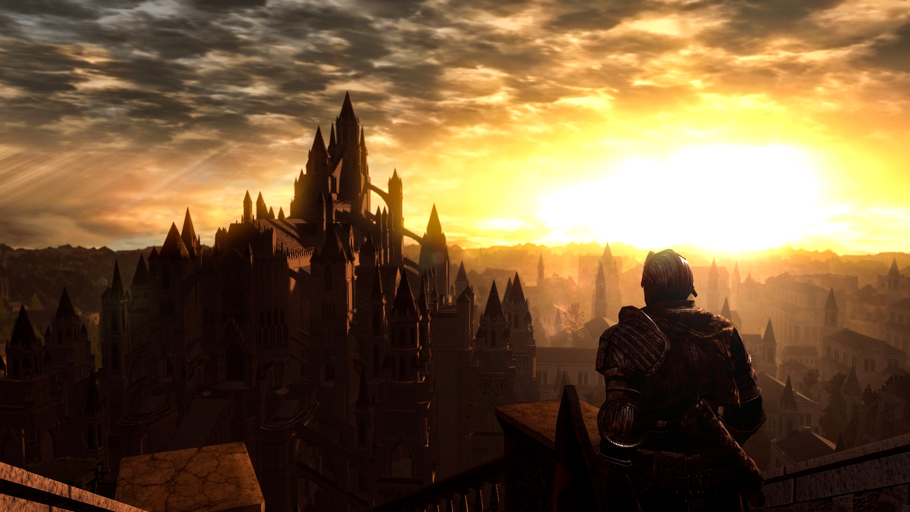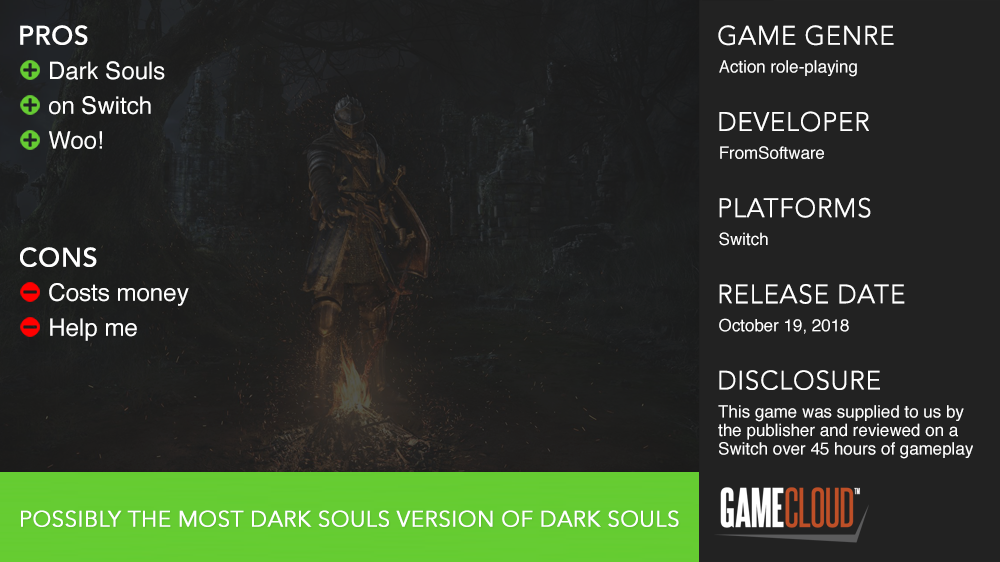
At this point enough has been written about Dark Souls and its sequels to make a naive review fairly redundant. Even if you haven’t played From Software’s 2011 hit, you probably know about it since it’s become its own cliche: the self-perpetuating mythology, famous difficulty, sense of mystery, recursive world structure and deft RPG sparkle. Maybe you’ve even played one or more of the squillions of “souls-like” games that have been released unto the world in the years since. So I’m not so invested in telling you what playing Dark Souls is like, in a broad conceptual sense. Instead, my main interest here was determining whether the Switch port of the Remastered version would be more or less quintessentially Dark Souls than the original, urm, Dark Souls.

To whit, I began my journey into Lordran on one sunny October morning while IRL sitting on a train that would take me several hours away into Australia’s interior. But this meant, first of all, making a character – a truly cumbersome task for someone as indecisive as I, made all the worse and authentic by being away from a computer where I could check the ramifications of my potential choices. Oh no! Going in blind. Speaking of blind, I then had to contend with glare on the screen from the train window which made the game hard to see. I wasn’t sure if this was the experience Hidetaki Miyazaki intended, but also I wasn’t not sure. After all, couldn’t an extra layer of real life augmented difficulty, in fact, make Dark Souls more Dark Souls than Dark Souls? Yes.
Similarly, I couldn’t be sure whether there was merit in having my Dark Souls experience frequently interjected with, e.g. raucous toddlers stomping up and down the train aisle, a stranger sitting on a laptop and slurping orange juice, the endless clacking and swaying concomitant with a long train journey. On the one hand, it may be less than ideal to continually have your attention pulled from your game of Dark Souls, but on the other hand, having your attention pulled and subsequently dying in particularly clumsy ways seems like something that FromSoftware would say improves their game. When I accidentally slipped off a bridge in Undead Burg and lost 5000 souls worth of accumulated failures (to the value of several level-ups, during the early game) and found myself unable to verbalise my frustration at this relatively upsetting turn of circumstances due to my public surroundings, instead screaming inwardly and probably therefore causing myself later-in-life health problems, I wondered if this, too, was more Dark Souls than Dark Souls. A senior woman making her way to the buffet car shook her head at me sadly. “Git gud,” she said, or might have said – I couldn’t hear through my headphones.

On the return journey, I once again shifted several hundred kilometres IRL, while in Lordran my character remained permanently fixed to one increasingly woeful campfire in Undead Burg. I tried not to think about the symbolic power of this scenario but appreciated that it seemed like quite a compellingly Dark Souls juxtaposition, that I could go on a long journey in real life while getting (in measurable terms at least) nowhere in this game. Truly, this seemed even more Dark Souls than Dark Souls. A lack of internet during this first public/mobility test lead to a lonelier, isolated world – no shadows, no blood-stains, no wilfully misleading messages – which I could not ascertain made the game more or less Dark Souls. Handily playing the game “offline” made it easier to hop in and out of from the Switch’s homepage. Thereafter at home when I was hooked up to the internet’s juices, returning to the game almost always involved a convoluted process of being dumped back into the menu screen – this, at least, seemed like a more Dark Souls experience.
At home, the Nintendo Switch continues to provide options for how you want to experience Dark Souls. For instance, you can choose to play Dark Souls in bed while hungover. Some might say this is the ideal state in which to play Dark Souls because the very real headache and vague yearning for penance caused by your hangover will line-up nicely with the vaguely punishing head-against-brick-wall sensation of playing Dark Souls. You may also choose to go into the living room and dock your Switch to the TV, which will allow your housemates to laugh at your increasing frustration and, hopefully, eventually, triumph, as you do the same thing over and over again only to fail as you, e.g. get shredded by the Capra Demon fifteen times in a row. It isn’t that you couldn’t do these things on other consoles before, of course, but now you can do either of them without much foresight or preparation.

Dark Souls, of course, is not the first game to throw the player into difficult boss fights without giving them a clue as to how to win, though it certainly goes above and beyond with making sure many boss fights can only be reached after a long jog from the nearest campfire, with many cliffs and enemies along the way in order to give you every chance of losing the thousands of souls you’ve been building up in your unceasing quest to learn what the heck just you’re meant to do, here, actually. On Switch this feels even more precarious, because oftentimes you’ll be playing it in handheld mode, and in these moments of intense frustration you’ll have to check yourself lest you take it out on the controller, because here the controller is the entire, expensive console, which probably won’t take so kindly to being put down extra firmly on a desk, or whatever it is you usually do to vent your frustration when you fail at games.
It looks nice, too, although I’m not sure if this makes it more or less Dark Souls. The moody vistas of Lordran are still occasionally breathtaking. Enemies are crisp and clear enough against the gloom that you should never be blaming the graphics for your certain and untimely deaths. I haven’t found much to fault with the game’s performance on Switch, more generally. It’s true that it technically has a lower frame-rate and worse sound than the other Remastered versions, but I can’t say I particularly noticed or was bothered by this personally. The loading times after “You Died” sometimes seem a couple of seconds too long but, also, this feels right. I’m happy to say, as well, that the infamous Blighttown section isn’t plagued by the frustrating framerate problems that reportedly dogged the original release versions, and is now merely frustrating for the same host of difficulty-related reasons that every other area of Dark Souls is frustrating.

Dark Souls seems pretty at home on the Switch (which all up is not a particularly surprising conclusion to come to since this console launched with a Zelda title, and Dark Souls is basically Zelda but difficult… Haha, don’t look at me like that, I’m kidding. No really). Should you pay full price to get it, though? I don’t know. It apparently costs the same on PC at the moment too, and if you’re strictly comparing the two options, well, Switch seems like a smart one. I don’t know if Dark Souls on Switch is the most Dark Souls version of Dark Souls, but it sure gives you a lot of options as to how you want to suffer through it.











